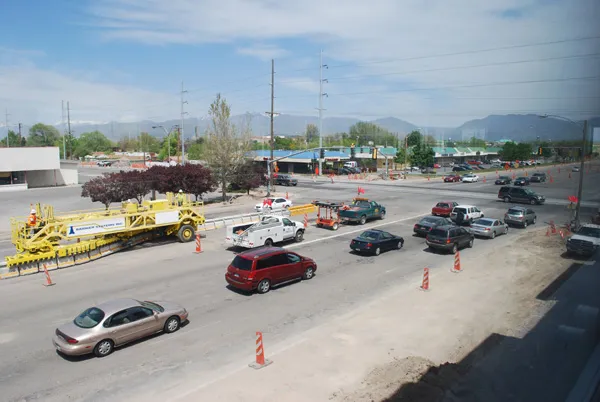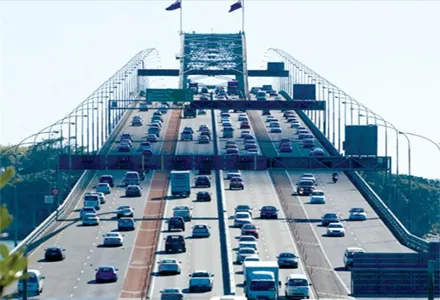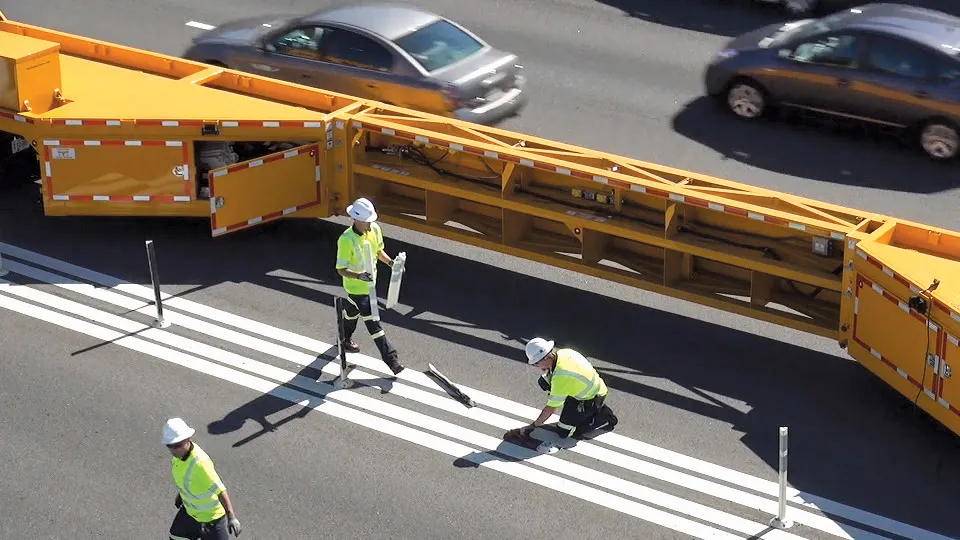A road project in Utah has benefited from the use of effective barrier protection during construction. *Paul Grant reports An upgraded section of road from 3500 South in West Valley City, Utah, is now open to traffic. The link was completely rebuilt by Utah DoT (UDOT) from the Bangerter Highway to 2700 West, and the road carries traffic from West Valley toward downtown Salt Lake City and the University of Utah. The work added two centre lanes, which are now the first dedicated Bus Rapid Transit lanes in Uta
February 10, 2012
Read time: 6 mins

RSS3359 Utah Department of Transportation (UDOT) from the Bangerter Highway to 2700 West, and the road carries traffic from West Valley toward downtown Salt Lake City and the University of Utah. The work added two centre lanes, which are now the first dedicated Bus Rapid Transit lanes in Utah. In addition the project replaced sidewalks and added raised medians.
Traffic volumes are high and range between 38,000-48,000 vehicles throughout the corridor, so keeping traffic moving was an important task during construction. The first phase of the project called for two lanes to be open for traffic in each direction and plastic barrels were used to separate directional traffic and to delineate the work zone. However, the work zone area was confined and restricted and also lacked positive protection for site personnel, which created dangerous conditions on occasions when confused motorists turned into the working area. In addition, accidents occurred when drivers made left turns into businesses through the barrels, contributing to congestion. The contractor required a larger and more protected work space, and the traffic management plan needed a way to limit the number of left hand turn options for motorists without restricting traffic flow.
To tackle safety concerns and improve the work space for the second phase of the project, it was decided that a moveable barrier system would be used. This could deliver the larger work zone, while minimising the impact on traffic and reducing the risks posed by vehicles making left-hand turns. The use of this system has been of note as moveable concrete barriers have historically been used only on highways and bridges. This was the first time that a moveable barrier was used on a major arterial link in the US.
The moveable barrier used on 3500 South is a two-part system. The first part consists of 1m sections of reinforced concrete that are pinned together at each end to form a continuous barrier wall. The barriers feature a modified T-shaped top, which acts as a lifting surface for the transfer machine. The second part of the system is a special transfer machine, which lifts the barrier and passes it through an inverted conveyor system, moving the sections 1.2 - 5.5m in one pass. To maximise safety the ends of the barrier are protected with the ABSORB 350 crash cushion from165 Barrier Systems Inc, a water-filled crash cushion that is also pinned together with a T top allowing it to be moved by the transfer machine.
It was determined that using the moveable barrier allowed two lanes to be kept open to traffic in the peak direction by using only three lanes, instead of the four lanes required when using barrels. This gave the contractor an extra lane to expand the work zone, keeping workers safe and speeding construction. Some 2.7km of moveable barrier was deployed to separate east and westbound traffic, and the barrier was moved several times/day to best suit vehicle flow. The barrier was transferred 3.7m, or one lane width, in one pass at 8km/h. The entire transfer took approximately 20 minutes, including repositioning the traffic control and signage.
With the expanded work zone, the contractor was able to use larger, more efficient equipment and work unimpeded for longer periods of time while the barrier was in place. This helped eliminate an entire phase of construction, reducing the total number of phases from three to two and the faster construction schedule helped the contractor to finish the project seven months early. In a report commissioned by UDOT and compiled by2404 T. Y. Lin International, the user delay savings from the early completion were estimated at US$1.3-1.4 million (although vehicle operating costs were not included). The benefits that were determined from the use of moveable barrier included reduced user costs, shorter travel distances, improved safety, lower impacts to businesses, early project completion, less fuel use, and reduced air emissions. The report conservatively estimated the total benefits of using moveable barrier on the project of US$1.7-2.4 million, with a benefit/cost of 4:1. The authors also stated that if all benefits were considered (such as the reduced air emissions and benefits of early completion for businesses), the benefit/cost for moveable barrier would be greater than 10:1.
The barrier limited left hand turns except at five major intersections, which reduced accidents and helped keep traffic running smoothly. The report estimates that based on the average number of left-hand turns in the corridor, the barrier eliminated 20 to 25 left-turn crashes while in operation, with an estimated reduction in crash costs of an additional $1 million.
On 3500 South, moveable barrier was used as a moveable median, where the barrier is placed between directional traffic and shifted to change the number of lanes available in the peak traffic direction. Moveable barrier is also commonly used in edge-of-road applications, where construction is taking place on the shoulder or median. In this configuration, the barrier is used to expand and contract the work zone, giving more lanes to the contractor during off-peak hours, and returning lanes to traffic during peak hours to respond to peak demands. For full-width construction, the contractor can close one side of a divided road or highway completely and divert all traffic to the other side during off-peak hours, using the barrier as a moveable median while accelerating construction and maximising safety for crews and motorists.
The Quickchange Moveable Barrier (QMB) is well proven in US construction work as well as overseas, having been used for over 25 years. Regarding the use of QMB moveable barrier on the 3500 South job, the TY Lin's report said, "Moveable barrier provides the ability to separate more of the highway corridor for use by the contractor which aids in completing the work more quickly... moveable barrier is definitely beneficial in high volume corridors where the morning and evening traffic split vary significantly. This traffic control strategy should be considered for use to manage congestion and improve safety on future projects."
*Paul Grant is a road safety consultant who has been involved with moveable barrier for over 10 yearsRSS
A road project in Utah has benefited from the use of effective barrier protection during construction. *Paul Grant reports
An upgraded section of road from 3500 South in West Valley City, Utah, is now open to traffic. The link was completely rebuilt byTraffic volumes are high and range between 38,000-48,000 vehicles throughout the corridor, so keeping traffic moving was an important task during construction. The first phase of the project called for two lanes to be open for traffic in each direction and plastic barrels were used to separate directional traffic and to delineate the work zone. However, the work zone area was confined and restricted and also lacked positive protection for site personnel, which created dangerous conditions on occasions when confused motorists turned into the working area. In addition, accidents occurred when drivers made left turns into businesses through the barrels, contributing to congestion. The contractor required a larger and more protected work space, and the traffic management plan needed a way to limit the number of left hand turn options for motorists without restricting traffic flow.
To tackle safety concerns and improve the work space for the second phase of the project, it was decided that a moveable barrier system would be used. This could deliver the larger work zone, while minimising the impact on traffic and reducing the risks posed by vehicles making left-hand turns. The use of this system has been of note as moveable concrete barriers have historically been used only on highways and bridges. This was the first time that a moveable barrier was used on a major arterial link in the US.
The moveable barrier used on 3500 South is a two-part system. The first part consists of 1m sections of reinforced concrete that are pinned together at each end to form a continuous barrier wall. The barriers feature a modified T-shaped top, which acts as a lifting surface for the transfer machine. The second part of the system is a special transfer machine, which lifts the barrier and passes it through an inverted conveyor system, moving the sections 1.2 - 5.5m in one pass. To maximise safety the ends of the barrier are protected with the ABSORB 350 crash cushion from
It was determined that using the moveable barrier allowed two lanes to be kept open to traffic in the peak direction by using only three lanes, instead of the four lanes required when using barrels. This gave the contractor an extra lane to expand the work zone, keeping workers safe and speeding construction. Some 2.7km of moveable barrier was deployed to separate east and westbound traffic, and the barrier was moved several times/day to best suit vehicle flow. The barrier was transferred 3.7m, or one lane width, in one pass at 8km/h. The entire transfer took approximately 20 minutes, including repositioning the traffic control and signage.
With the expanded work zone, the contractor was able to use larger, more efficient equipment and work unimpeded for longer periods of time while the barrier was in place. This helped eliminate an entire phase of construction, reducing the total number of phases from three to two and the faster construction schedule helped the contractor to finish the project seven months early. In a report commissioned by UDOT and compiled by
The barrier limited left hand turns except at five major intersections, which reduced accidents and helped keep traffic running smoothly. The report estimates that based on the average number of left-hand turns in the corridor, the barrier eliminated 20 to 25 left-turn crashes while in operation, with an estimated reduction in crash costs of an additional $1 million.
On 3500 South, moveable barrier was used as a moveable median, where the barrier is placed between directional traffic and shifted to change the number of lanes available in the peak traffic direction. Moveable barrier is also commonly used in edge-of-road applications, where construction is taking place on the shoulder or median. In this configuration, the barrier is used to expand and contract the work zone, giving more lanes to the contractor during off-peak hours, and returning lanes to traffic during peak hours to respond to peak demands. For full-width construction, the contractor can close one side of a divided road or highway completely and divert all traffic to the other side during off-peak hours, using the barrier as a moveable median while accelerating construction and maximising safety for crews and motorists.
The Quickchange Moveable Barrier (QMB) is well proven in US construction work as well as overseas, having been used for over 25 years. Regarding the use of QMB moveable barrier on the 3500 South job, the TY Lin's report said, "Moveable barrier provides the ability to separate more of the highway corridor for use by the contractor which aids in completing the work more quickly... moveable barrier is definitely beneficial in high volume corridors where the morning and evening traffic split vary significantly. This traffic control strategy should be considered for use to manage congestion and improve safety on future projects."
*Paul Grant is a road safety consultant who has been involved with moveable barrier for over 10 yearsRSS








